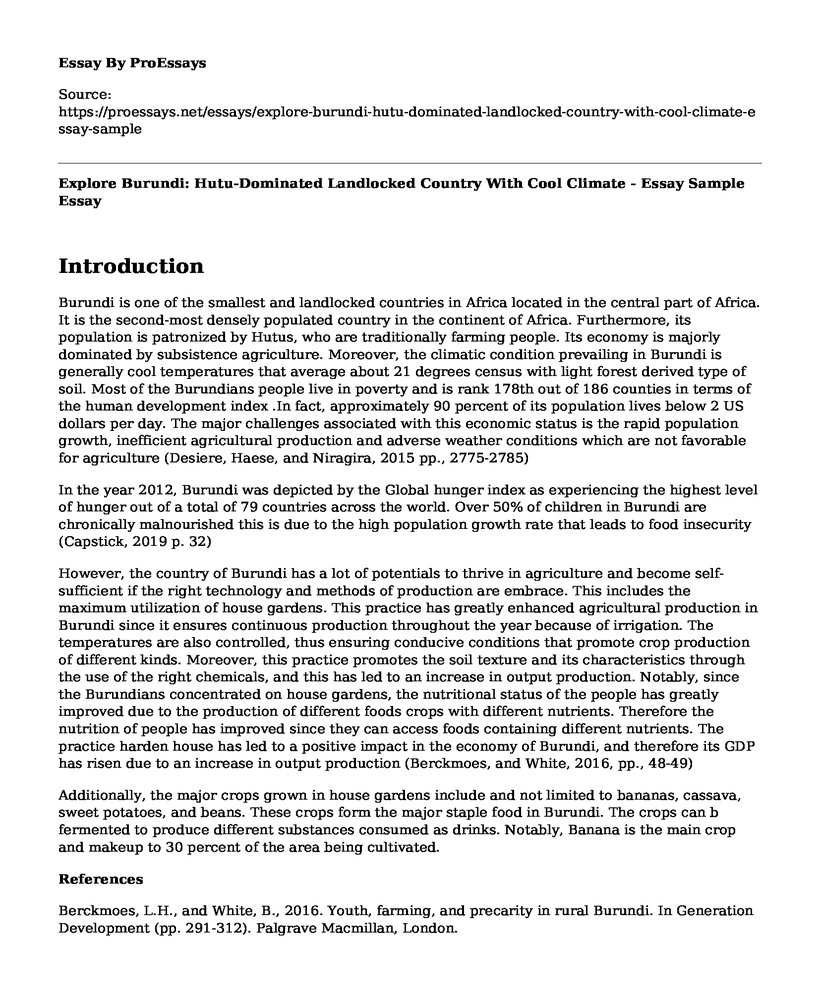Introduction
Burundi is one of the smallest and landlocked countries in Africa located in the central part of Africa. It is the second-most densely populated country in the continent of Africa. Furthermore, its population is patronized by Hutus, who are traditionally farming people. Its economy is majorly dominated by subsistence agriculture. Moreover, the climatic condition prevailing in Burundi is generally cool temperatures that average about 21 degrees census with light forest derived type of soil. Most of the Burundians people live in poverty and is rank 178th out of 186 counties in terms of the human development index .In fact, approximately 90 percent of its population lives below 2 US dollars per day. The major challenges associated with this economic status is the rapid population growth, inefficient agricultural production and adverse weather conditions which are not favorable for agriculture (Desiere, Haese, and Niragira, 2015 pp., 2775-2785)
In the year 2012, Burundi was depicted by the Global hunger index as experiencing the highest level of hunger out of a total of 79 countries across the world. Over 50% of children in Burundi are chronically malnourished this is due to the high population growth rate that leads to food insecurity (Capstick, 2019 p. 32)
However, the country of Burundi has a lot of potentials to thrive in agriculture and become self-sufficient if the right technology and methods of production are embrace. This includes the maximum utilization of house gardens. This practice has greatly enhanced agricultural production in Burundi since it ensures continuous production throughout the year because of irrigation. The temperatures are also controlled, thus ensuring conducive conditions that promote crop production of different kinds. Moreover, this practice promotes the soil texture and its characteristics through the use of the right chemicals, and this has led to an increase in output production. Notably, since the Burundians concentrated on house gardens, the nutritional status of the people has greatly improved due to the production of different foods crops with different nutrients. Therefore the nutrition of people has improved since they can access foods containing different nutrients. The practice harden house has led to a positive impact in the economy of Burundi, and therefore its GDP has risen due to an increase in output production (Berckmoes, and White, 2016, pp., 48-49)
Additionally, the major crops grown in house gardens include and not limited to bananas, cassava, sweet potatoes, and beans. These crops form the major staple food in Burundi. The crops can b fermented to produce different substances consumed as drinks. Notably, Banana is the main crop and makeup to 30 percent of the area being cultivated.
References
Berckmoes, L.H., and White, B., 2016. Youth, farming, and precarity in rural Burundi. In Generation Development (pp. 291-312). Palgrave Macmillan, London.
Capstick, M., 2019. The economics of agriculture. Routledge.
Desire, S., D'Haese, M., and Niagara, S., 2015. Assessing the cross-sectional and inter-temporal validity of the Household Food Insecurity Access Scale (HFIAS) in Burundi. Public Health Nutrition, 18(15), pp.2775-2785.
Cite this page
Explore Burundi: Hutu-Dominated Landlocked Country With Cool Climate - Essay Sample. (2023, Mar 24). Retrieved from https://proessays.net/essays/explore-burundi-hutu-dominated-landlocked-country-with-cool-climate-essay-sample
If you are the original author of this essay and no longer wish to have it published on the ProEssays website, please click below to request its removal:
- Essay Example on Japan and Globalization: Social Change and Impact
- Essay Sample on U.S. Economy: Government Intervention vs. Laissez-Faire
- Air Pollution in China Essay
- Impacts of Divorce on Family: Data-Backed Analysis - Essay Sample
- Essay Example on History of Reconstruction: 1865-1877 in the USA
- Essay Sample on My Dream of Visiting the Bible Land Museum in Israel
- Free Report Sample on Canadian Red Cross: Humanitarian & Community Support







